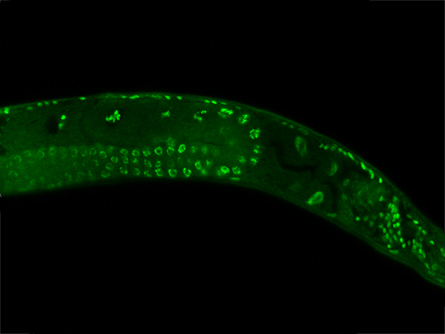- More than 2 years ago
Although long life can be inherited, it doesn’t necessarily happen through the genes.

A new study shows that the grandchildren and great-grandchildren of long-lived roundworms live five to six days longer than usual even though they no longer carry the genetic mutations that caused their grandparents’ longevity. Instead, the descendants’ longevity may be because they inherited epigenetic marks — chemical tags on their DNA or DNA-associated proteins called histones — that change gene activity without changing the genes themselves, researchers at Stanford and Harvard universities report online October 19 in Nature.
The study is the first to demonstrate that longevity can be passed from generation to generation via these chemical tags known as histone modifications rather than by DNA variations. Only a few studies have suggested that any histone modifications can be inherited, “but this is a fairly definitive demonstration,” says Tony Kouzarides, a molecular biologist at the University of Cambridge in England.
Working with the roundworm Caenorhabditis elegans, researchers led by Eric Greer and Anne Brunet at Stanford previously found specimens that live 20 to 30 percent longer than normal. These long-lived worms had mutations that disrupted their ability to make a particular epigenetic mark on a histone protein called H3. Histones are proteins that spool DNA so it fits in a cell, and they help control gene activity.
Greer and Brunet found that these worms have trouble adding three methyl groups to a particular lysine in the chain of amino acids that make up H3. This mark is almost always found on histones located near the beginning of active genes. Worms that can’t make the mark may have less-active genes or may shut down some genes entirely.
But the true test of whether a particular mark on DNA or histones is epigenetic is whether the effect can be inherited. So Greer designed a new experiment to find out whether worms that didn’t have mutations in the histone-marking genes could nevertheless inherit long lives.
“I didn’t really expect it to be inherited,” because it’s generally thought that histone marks are erased between generations, says Greer, who is now working at Harvard.
But longer lives were inherited for at least three generations, even though the descendants of the mutant worms no longer carried the DNA change that originally caused the life span extension, the researchers found. Histone marks in the long-lived progeny looked normal, but the activity of certain genes in the descendants mirrored activity in the mutant ancestor.
The life-extending ride ended abruptly between the third and fourth generations, the study found. The reason is unknown, but Brunet speculates that each generation may gradually reestablish some of the marks until a threshold is reached and the life extension is cut off.
No one knows whether the finding in C. elegans will be true for other animals or people, but many aging processes found in worms are also at work in other organisms, including humans.
“It’s always thought to be genetics — actual mutations in the genome — that allow people to live longer, but certainly there could be epigenetic factors involved as well,” says Brian Kennedy, chief executive officer of the Buck Institute for Research on Aging in Navato, Calif.
The team hasn’t yet worked out exactly how long life is passed from generation to generation. “It’s very mysterious, and it’s always great to have a new mystery,” says Cynthia Kenyon, a molecular geneticist at the University of California, San Francisco. “It’s a profound result.”






